 |
  |
 |
  |
Tandava across art: Exploring Dr. Kapila Vatsyayan's diverse representation of Tandava - Kiran Java e-mail: kiran@kiranjava.com August 5, 2023 Dr. Kapila Vatsyayan has extensively delved into the Tandava style dance, exploring it from various perspectives across different art disciplines. Through this exploration, Dr. Vatsyayan aimed to understand the theoretical foundation underlying the formation of dance traditions and techniques. She examined several treatises on art to ascertain a comprehensive understanding of Tandava in those respective texts. She identified instances of Tandava in the following texts and illuminated the different interpretations attributed to each of them. Dr. Kapila Vatsyayan has identified the following disciplines of art and literature that feature the concept of Tandava. These are arranged in the categories of dance treatises, lexicon, literature, and sculpture and are listed as follows: 1. Dance Treatises a. Natyashastra2. Lexicon a. Amarakosha3. Literature a. Tandava Stotra4. Sculpture/Art a. Gupta Period Sculpture I. Treatises a) Natyashastra Dr. Kapila explains that Bharata used Natya as a generic term. Bharata had identified the category of Nritta as pure movement without meaning. He divided it into Tandava and Sukumara as modes of rendering. He did not specifically relate these to male or female. The Karanas in Tandava and Sukumara could be performed by either. Dr. Kapila Vatsyayan mentions that Bharata had the notion of two modes of rendering movement - energetic i.e. Tandava and gentle i.e. Sukumara. It should be noted that in the description of the ten types of drama, Lasya is one of the forms mentioned. The Natyashastra defines Tandava as follows:
In the domain of medieval treatises, Dr. Vatsyayan has cited the Abhinaya Darpana and Sangeet Ratnakar as significant examples. The Abhinaya Darpana is a text on dance attributed to Nandikeshwara and dated variously between the 6th to 11th centuries. Sangeet Ratnakar meaning 'Ocean of Music and Dance', was composed by Sharangdeva in the 13th century CE. Dr. Kapila Vatsyayan states that according to the Abhinaya Darpana, the Sangeet Ratnakar, and other medieval treatises, dance was given an independent status. It is known as a generic category termed Natanam and is divided into three distinct categories, i.e.
These texts also characterize dancing as Tandava and Lasya. Tandava is attributed to males and Lasya is attributed to females. c) Orissa dance texts Dr. Kapila Vatsyayan explains that another source of evidence concerning Tandava is found in the manuscripts of Orissa. These are the manuscripts that deal with the dance of Shiva and describe in detail the Tandava of Shiva. They not only describe the theme of the Tandava, for example, Ananda Sandhya but also describe in detail the manner in which the Tandava is to be executed. The repertoire of Odissi, like other classical dance forms of India, is divided into the two broad categories of Nritta and Abhinaya and Tandava and Lasya. Some manuscripts from Orissa do not follow the Natyashastric tradition; instead, they adhere to the tradition of the Saudhikagamas. Dr. Vatsyayan notes that it is evident that there was an interchange between Orissa and South India because many of the descriptions of the Tandavas are on the same lines as the descriptions that are in the South Indian agamas. d) Manipuri dance texts Sangita Lila Vilas is an important text on the details and fundamentals of Rasa dances of Manipur. The text is attributed to King Bhagyachandra. Legend has it that King Bhagyachandra was an ardent devotee of Lord Krishna. One night he had a vision that Lord Krishna was dancing the Rasa dances with the gopis. Inspired by this vision, he composed the 'Rasa Lila' dance of Manipur. It was first performed at the Govindji Temple at Imphal. Dr. Kapila Vatsyayan states that the authorship as well as the date of Sangita Lila Vilas is a subject of hot debate. However, one cannot deny that it contains a rich source of material to understand the techniques of Manipuri dance. On the whole, the text follows the Natyashastra tradition but it is not an imitation or copy of the Natyashastra. This is apparent from some significant themes. In the Sangita Lila Vilas, both Tandava and Lasya are defined. This is an interesting fact because this is not found in the treatises of the medieval period from other parts of India. The Tandava is divided into the Chalanam and the Gunthanam. Lasya is also subdivided into Simitanga and Sphuritanga. This classification is distinctive to this work and is followed to this day in contemporary practice. Dr. Vatsyayan has mentioned the Tandava described in Sangita Lila Vilas as follows: The Tandava is known for its agility, verve, and high leaps, whether executed by women in the role of the child Krishna or by men in the numerous male dances of the region. The text states that the basic position in Tandava has a four tala distance between the two feet and the knees are bent in front. In the Tandava portions, the torso is occasionally treated as a separate unit and side bends are frequent. There are many sitting positions and many spirals and turns - in the Tandava portions, the sthanakas take the form of positions known as the Vrischika Karanas of the Natyashastra tradition. II. Lexicon a) Amarakosha The Amarakosha, a later but important Sanskrit lexicon, mentions several terms of music, dancing, and rhythm. It was composed by the Indian scholar and poet Amarasimha, believed to have lived around the 5th or 6th century CE. It devotes one complete varga (sub-chapter) to the subject of dramatics. Dr. Kapila states that the Amarakosha includes a comprehensive list of all the categories of dancing. It lists five categories of dancing, viz., Tandava Natakam, Natyam, Lasyam, Nritya and Nartana (I. 7. 10). III. Literature a) Tandava Stotra Dr. Kapila Vatsyayan explains that according to a later Indian tradition, Ravana was not only a great composer, an accomplished musician, and adept at playing the drum and the Indian lute but was also one of the cleverest dancers. It is said that his music and dance pleased Shiva so much that the three-eyed god presented him with a sword called Chandrahasa (laughter of the moon) and adopted him as one of his foremost devotees. Sanskrit devotional literature preserves till today the text of the dance music which Ravana is said to have composed and interpreted in gesture language and to which he danced before Shiva. He is said to have performed some of the most intricate and complex of the god's own Tandava steps. b) Kumarasambhava The Kumarasambhava is a Sanskrit play by Kalidasa and is widely regarded as his finest play. The date of the play is not certain but it is believed that Kalidasa lived around the 5th century CE. Kumarasambhava literally means 'the birth of Kumara'. The play is in seventeen cantos and has Shringara rasa as its theme. The demon Tarakasura obtained a boon that he would be killed by Shiva's son. The demon started vanquishing the Devas. The Devas sought the help of Lord Shiva to end the demon's tyranny. However, Shiva was in deep meditation and did not have a consort at that time. Therefore, there was no immediate chance of a son being born who could fulfill the conditions of the boon given to Tarakasura. The Devas requested Lord Kamadeva, the god of love and desire, to intervene. Kamadeva used his powers of attraction to disturb Shiva's meditation and evoke feelings of love in him. As a result, Shiva was awakened from his meditation and eventually married Goddess Parvati. 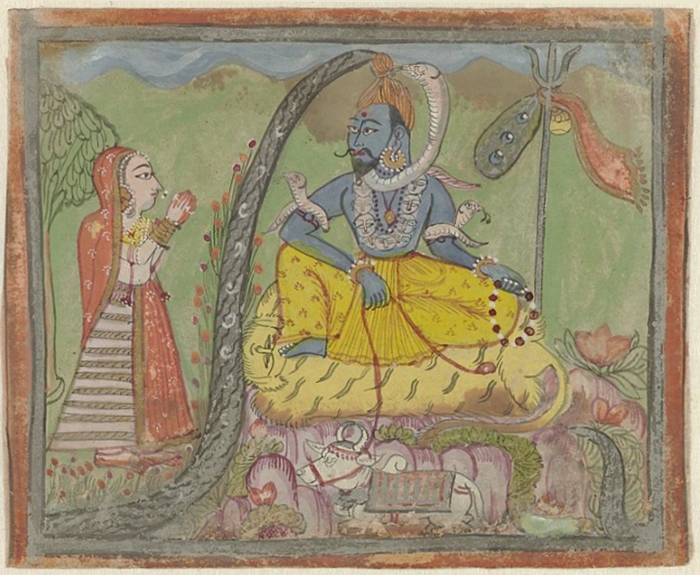 Shiva and Parvati, 1810 - 1830 CE, Kashmiri School (Source: Rijksmuseum) Dr. Kapila Vatsyayan states that since the creator and originator of the dance is the hero of Kumarasambhava, naturally, there are elements of dance-related imagery present. For example, there is a mention of the Sukumar dance of Parvati, the graceful abhinaya of the tree, and the dance of the peacocks. The text also described the grotesque dance of the ascetic Bhringi on the occasion of the marriage of Shiva and Parvati (IX. 48). Kalika dances with a garland of skulls for the couple (IX. 49). Parvati describes the dance of the Lord to the Brahmachari who enters into conversation with her: his ashes shed as he dances and she uses the phrase Nrityabhinaya Kriya rather than Tandava, the usual description (V. 79). c) Harshacharita The Harshacharita is the first composition of the playwright Banabhatta. He is the Sanskrit writer of the 7th century CE. He was the court poet of the Indian emperor Harsha. The Harshacharita chronicles the life and reign of the emperor. Dr. Vatsyayan states that Harshacharita mentions five types of goshtis which are understood as gatherings or assemblies. These are Kavyagosthi, Galpagosthi, Gitagosthi, Nrityagosthi, and Vadyagosthi. The mention of these five types of gosthis gives us an idea of how different groups of people would come together for various purposes in the times of King Harsha. We learn of various types of dancing in these gosthis. In the Harshacharita there is mention of the Tandava Nritya, telling us of the prevalence of the concept of Shiva dancing. d) Malavikagnimitram Malavikagnimitram is a five-act play by Kalidasa in the Sanskrit language. This is the first play by Kalidasa and deals with the episodes from the life of Agnimitra, the Shunga king. It describes Agnimitra's love for the Vidharbha princess Malavika. Dr. Kapila Vatsyayan has noted that Kalidasa's dramas deal with dancers, but in the Malavikagnimitram there is a unique reference, which is most valuable for our purpose. In the play, there is an episode where Shiva, for the sake of this art, causes the left side of his body to become feminine i.e. he divides himself into two. According to Dr. Kapila Vatsyayan, this is an oblique reference to the two styles - Tandava and Lasya. Please note that the actual words Tandava and Lasya are not used, but, the very notion of Shiva dividing himself into two suggests the clear idea that there are two categories of dancing prevalent. e) Vikramorvashiyam Vikramorvashiyam is a five-act Sanskrit play by Kalidasa. It is based on the love story of King Pururavas and the heavenly apsara named Urvashi. This is the second of the three magnum plays written by Kalidasa. 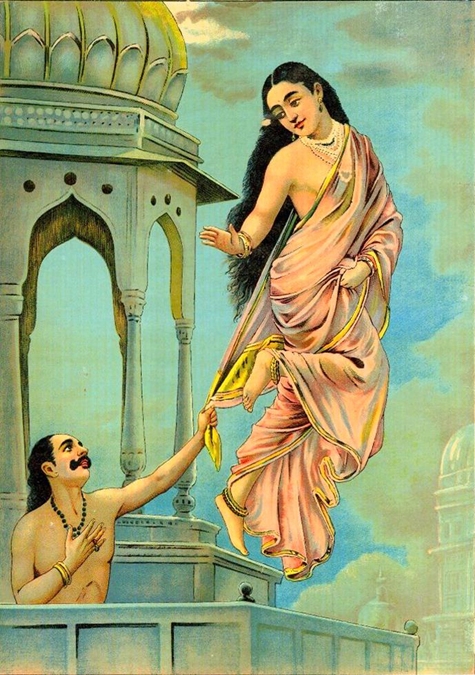 An 1890 painting by Raja Ravi Varma depicting Pururavas and Urvashi (Source: Wikimedia Commons) In the Vikramorvashiyam we see various types of dancing. Kuthilika and Mallaghati are two other unique styles of dance. Dr. Vatsyayan explains that the Kuthilika is done without raaga or the accompaniment of a song. It belongs to the Artta variety. It is described as a type of Tandava dancing as it is performed in the Ardhamattali. The Ardhamattali is a Karana of Bharata and is described by the commentator somewhat differently from Bharata. f) Malatimadhava Malatimadhava is a Sanskrit play by Indian playwright Bhavabhuti who lived around 700 CE. His dramas have vivid characterization and are known to have suspense. Malatimadhava belongs to a kind of play called 'Prakaran'. The play is a love story where Malati, the daughter of a minister of Padmavati, falls in love with Madhava, the son of a minister of Vidarbha; however, the King of Padmavati wants his minister to get his daughter married to another man. The love story is complemented by a very surprising theme of Tantra and Aghor-vidya. According to the renowned Sanskritist Daniel H.H. Ingalls, Malatimadhava is a work that 'combines love and horror with a felicity never again equaled in Sanskrit literature'. Aspects of Tandava Malatimadhava has extremely powerful descriptions of the dances of Shiva and Kali. In the prologue to Malatimadhava, Bhavabhuti invokes god Shiva in the aspect of the Tandava. In Act V, Shiva is seen dancing to the drum of Nandi. Malatimadhava also contains powerful descriptions of the dance of destruction. An example is Kapalikas (Tantric, non-Puranic form of Shaivism) bow to the goddess Chamunda and worship her in the aspect of the Tandava dance. Malati's perfect carriage of the body and her movements are described as beautiful and flawless: her training in these glances and movements has been dictated by a teacher of dancing, who is called the Natyacharya here. Tandava of the eyes Madayantika is a character in the play Malatimadhava. She is a friend of Malati and the sister of Nandana. In Act VIII, Madayantika describes her dream. This episode talks about the various movements of the eyes. Dr. Vatsyayan mentions that the movements are called the dance of the eyes and, surprisingly enough, the word Tandava is used here. She has also noted that the word Lasya is used as a synonym for the word Nritya very often; however, the word Tandava is seldom used. Tandava by peacocks The peacocks also perform Tandava, not merely Nritya. The peacocks that drown Madhava's words in their notes also perform the Tandava. It is significant how the words Nritya and Lasya are replaced here by Tandava. Dr. Vatsyayan states that one cannot conclude from this instance that the distinction between Tandava and Lasya was lost to the author, but it is clear that little distinction is maintained here between the different terms. g) Uttararamcharita Uttararamcharita is a Sanskrit play in 7 acts by Bhavabhuti. Uttararamcharita is based on the well-known story of Uttara Kanda of the epic Ramayana, with certain changes introduced by the poet. It describes the story of Ram and Sita after Sita's exile to the forest. It is in the style of 'Nataka'. 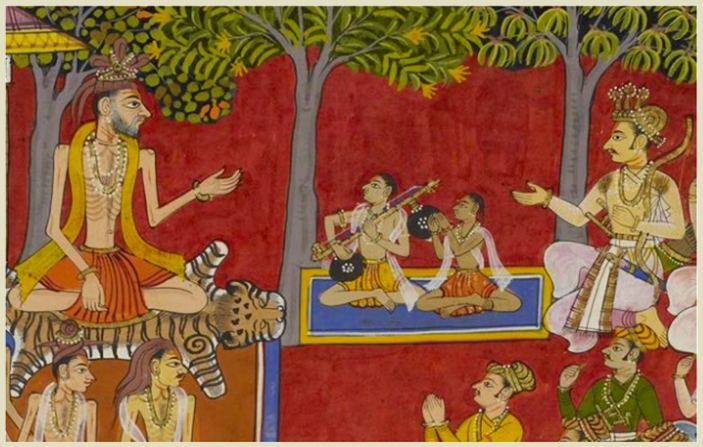 Luv and Kush in Valmiki's ashram: Uttararamcharita (Source: Wikimedia Commons) Dr. Kapila Vatsyayan explains that in the Uttararamcharita, Bhavabhuti exercises a little more restraint when compared to the Malatimadhava, and thus we have fewer descriptions of eyes, eye glances, and eyebrows. Tandava of the eyebrows and 'bhramana' of the peacock's eyes Rama fondly recalls how Sita used to make the young peacock dance with the gentle clapping of her hands. As the peacock danced to the rhythm, Sita gives the tala with her hands. Her eyebrows move vivaciously and their movements are specified as being Tandava. The eyeball movements of the peacock are described as circular and full of sportiveness. The movement of the eyeballs mentioned here is the 'bhramana'. This is mentioned in the Natyashastra as being where the eyeballs move in all directions and make a circle. Dr. Vatsyayan explains that the author seems to suggest a circular movement of the eyes in which the eyeball makes a complete circle. Therefore, to simplify the sentence he uses the descriptions of the Tandava of the eyebrows and the dance of the peacock. IV. Sculpture and Dancing a) Gupta Period The Gupta period was a significant phase of Indian art and culture, and sculptures of Shiva from this era are characterized by their refined artistic style and elegance. The Gupta Empire was an Indian dynasty that ruled over a large part of the Indian subcontinent from approximately 320 CE to 550 CE (4th century to early 6th century CE). According to Dr. Kapila Vatsyayan, the categorization of dance movements into two can be seen in the sculptures of this period. The dance sculptures are divided into Sukumara or Lasya on the one hand and the heroic or vigorous Tandava on the other. Examples of both types of dance can be seen in the sculptures of this period. 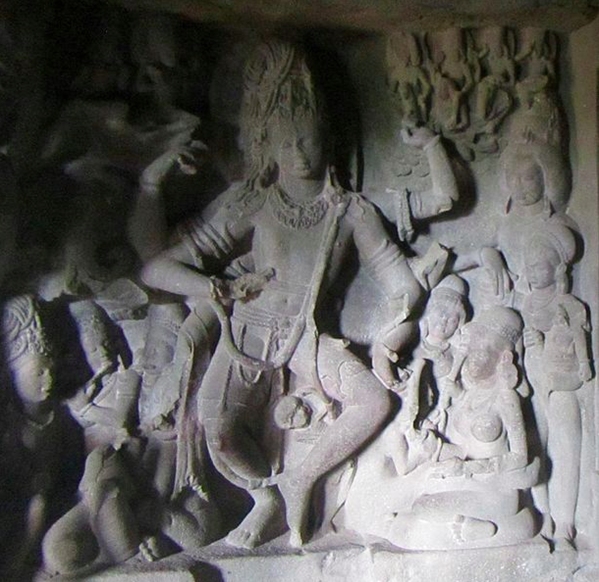 Dancing Shiva, Cave 21, Ellora (Source: Wikimedia Commons) This is also true especially of the later Vakataka period, especially in Ajanta and Ellora. There are 34 caves at Ellora dating from between the 6th and 11th centuries AD, and 29 caves at Ajanta dating back to between the 2nd century BCE and 6th century CE. Here, the various Tandava poses of Shiva can be seen. b) Khajuraho Khajuraho is a group of monuments that are located in Madhya Pradesh. The site is famous for its Nagara style architecture, graceful sculptures of various deities, and the sculptures of the 'nayika' or the female protagonist. Khajuraho was built in the medieval century i.e. between 950-1050 CE by the Chandela Dynasty. Some scholars date Khajuraho variously between the 8th and 11th centuries. The sculptures in Khajuraho are of both Hindu and Jain significance. Khajuraho is renowned as a UNESCO World Heritage site. Dr. Kapila Vatsyayan has remarked that the most significant pose among these sculptures is Shiva dancing. In the sculpture at Khajuraho, Shiva is dancing the Tandava. He performs a beautiful Vivartita (raising up) movement of the waist, hands in the extended dola hasta (pataka hasta is placed to the sides of the thigh), and the Prastha Swastika (crossed at the back) movement of the legs. One leg is in a clear Kshipta (thrown out) with a Sampada (standing posture) foot. The other leg is raised in possibly a Parshva Kranta Chari. c) Orissa Temples The Parasurameswar Temple (8th century CE), has several sculptures in postures of the Tandava dance. The temples of Bhubaneswar including the exquisitely carved Raja-Rani temple (11th century CE) and the grand temple, the Lingaraja have an abundance of dance sculptures. In these, there is a refining of techniques of execution of the movements of dance. There are the ganas of dance as well as standing figures of women, bursting out of stone, pulsating with rhythm. There are flying figures identified as Gandharvas and the Apsaras. There are full groups of dancers and there is the Tandava of Lord Shiva. Summary In summary, Dr. Kapila Vatsyayan's research delves into captivating aspects of Tandava across literature and the arts. Through her work, she explores Tandava in diverse disciplines like art, sculpture, lexicon, literature, drama, music, and dance treatises. Her research spans a time period from 250 BC to the medieval age, encompassing a wide array of texts. Her study successfully reveals the significance of Tandava and how its contextual placement varies across different disciplines. Furthermore, the changes in the evolution of the nature of Tandava over time are evident from her research. Acknowledgements: This exposition is part of my ongoing research on Exploring Tandava in the Bhagavata Purana. I would like to thank Dr. Shrikant Bahulkar, Chief Investigator, Bhagavata Purana Project, Bhandarkar Oriental Research Institute, Pune for recommending the reading of Dr. Kapila Vatsyayan's research on Tandava. References:
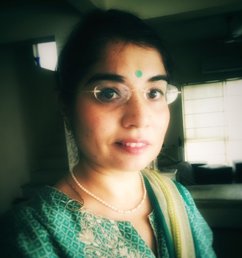 Kiran Java is a writer and author of 'My First Book of Kathak Dance' and 'Meeting the Kathak Rishi'. She holds a Masters degree in Journalism and Communication and a Bachelor's degree in Marketing from Eastern Connecticut State University, USA. She holds a Diploma in Natyashastra with Kathak relevancy and certification in Vallabh Vedanta from Mumbai University. For more information visit kiranjava.com Post your comments Pl provide your name and email id along with your comment. All appropriate comments posted with name and email id in the blog will be featured in the site. |